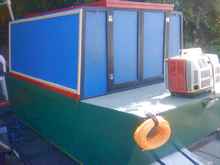
 Custom Search
|
|
| sails |
| plans |
| epoxy |
| rope/line |
| hardware |
| canoe/Kayak |
| sailmaking |
| materials |
| models |
| media |
| tools |
| gear |
 |
 |
| join |
| home |
| indexes |
| classifieds |
| calendar |
| archives |
| about |
| links |
| Join Duckworks Get free newsletter Comment on articles CLICK HERE |
|
|
| Microshanty |
by Bryan Lowe - Seattle, Washington - USA |
Have you ever noticed how little space you actually use in your house? Kitchen, bathroom, bedroom - just the bed for the most part, and someplace to sit. I've found the same is true on a boat. Where you sit, sit and cook, sit and read, sit and go to the bathroom, pull up to shore and go for a walk so that you can come back and sit some more and then go to sleep. The rest of the time you are going from one place sitting place to another. Isn't a boat used best to journey into the world around you? If so, when you take a boat out for a weekend, get out. Don't recreate your home. Use your boat to explore a new world. If that's your course, if that's the journey for you, boats just don't need to be big to go on small rivers and the like. In fact, smaller can really be far better. It costs far less to keep, to build, and to transport. And you can go anywhere there is protected water. Five inches in a shallow pond, lake or river? No problem, that's plenty for a small boat like this. That little creek that joins the river and goes who knows where? Head in and find out. I had a classic 1960's 28 foot Owens cabin cruiser. I spent more every month on that boat than I spent building this one. $350 a month moorage and $100 a month on old wood boat insurance. Gas? Crazy, of course. It's a rich man's hobby, a bit of fun for folks that don't mind that "hole in the water".
Enter the Micro-Shanty, the modest but cute little canal boat for the protected waters adventurer. It's 8 feet long and 4 feet wide, and as it turns out, a fun little boat. Small boats like this are a different thing all together. When it came time to build I already had the trailer. I had some of the wood. And the wood I did buy was maybe 4 sheets of exterior plywood and a bundle of trim pieces. And when I am done with the boat, whatever. I Give it away, throw it away, sell it if I want, but don't worry if I can't. We don't worry too much if we spend this kind of money on a couple of nights at a hotel sleeping in a bed we share with strangers! This sort of building means almost anyone can have a boat. And look where you can go, as in my shots of the Sammamish Slough - a modest little waterway weaving through a few cities on the east side of Lake Washington in Seattle. Launching for a year is a one time $35 fee. It's battery powered, so my costs, including a new battery, may be $100 a year. So what of my wife and family? I don't need the space because this is MY hobby, not theirs. My kids are building lives of their own now, and my wife's idea of fun does not include spending nights out on boats. So, we spend our time together doing different things. And when I go out on my own, why bring all that extra boat? I started the project months ago, designing and building, but hit the usual wall of time, low energy after a full day work, and the usual challenges of life. Then, on the way to it's first test launching I hit a huge pothole and the battery cracked the bottom at a weak joint. So, after moping for a few months I decided that I was going to make just enough progress on this little boat, do just enough of a repair, to allow me to test it. Was I too big for it making it too tender? Would it skitter around like a leaf in the wind? If it became clear the boat didn't work I would give it to some neighbor kids to use as a playhouse. They were more than game! If it seemed a viable solo camper for calm and protected waters, I would finish the build and go out for a couple of nights to give it the big test.
The verdict? It worked. On my first ever journey away from the dock in my self designed Micro Shantyboat, I spent a beautiful day cruising. I did it after spending maybe $350 on materials. I did it after towing the boat and trailer with my standard modestly powered old Chevy. It was a journey of a few hours heading up the Sammamish Slough, an infrequently used waterway on the north end of Seattle's Lake Washington, amongst kingfisher and heron, floating from neighborhoods to secluded and shady bends in the river. It' was such a mind cleanse, made even better knowing I made it with my own hands and a relative fistful of dollars. But how does the boat handle? It is only 8 feet by 4 feet, so it does lean toward tender, but if you sit in a lawn chair in the middle of the boat you are fine. It's unlikely the little barge will flip, but it is at it's best, it's the most comfortable, if you just sit down as the world floats by. A little boat like this, with all that color and the funky shape, certainly gets attention. Along the way people came out of their houses to proclaim, "that's adorable!" As is usually the case, there was a macho contingent that clearly felt a bit embarrassed for me, but I am the darling of the moms and older crowd. For a slow journey on a quiet river it's form follows function, but with a little charm and color thrown in for fun. (The paints, by the way, were mostly left over from house projects. Paint from a deck for the hull, blue from a door, and some other colors we bought as samples before painting the house. Never fear color and lots of it.) Vintage electric trolling motor from Craigslist is paired with a large car battery. It did a good 3 hours of trolling, and barely made it back to the launching area! I have an old 400 watt Honda generator I bought for $100 and it has a 12v battery charging outlet. I'll bring it next time if I want to go any further. Truth be told, there was a small leak somewhere from that old crack. I've removed the cabin and turned the boat over, and once it dries, I'll put on a layer of epoxy and paint, and then take it out for it's first overnight. So the verdict? Success, this little design works. It's affordable and it let's you go into the really small water where most others fear to tread. The boat is good. Life is good. Want to build your own? At this point there are no plans. I recommend using the DockBox plans from Jim Michalak and then making it your own as your skills allow. At some point I may offer plans at ShantyboatLiving.com and Shantylife.com if there is any interest. You can also check out some of the ideas from Deek at https://relaxshacks.blogspot.com or start designing your own! |
 |






